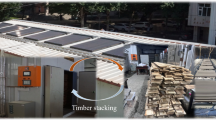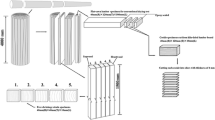Abstract
Sub-alpine fir is characterized by its high proportion of wet pockets making it difficult to dry. Since it takes longer to dry, mills experience reduced kiln productivity and increased energy consumption. High temperature drying (HTD) can be an effective approach to accelerate the drying process. In this study, three drying schedules, namely, conservative (control), HTD, and HTD and conservative combined (HTD/Cons), were evaluated when drying green sub-alpine fir 2″ × 4″ dimension lumber. The results indicated that: (1) the drying rates in the HTD and HTD/Cons schedules were increased by 31–150% in comparison to the drying rates obtained for the conservative schedule; (2) although drying stresses observed for the HTD schedule were higher than those that were measured for the conservative schedule, no significant difference in drying stresses was found between the HTD/Cons and conservative schedules; (3) warp was reduced in both HTD and HTD/Cons schedules; (4) neither the HTD nor HTD/Cons schedule showed any significant reduction in modulus of rupture (MOR) and modulus of elasticity (MOE) when compared to the values obtained for the conservative schedule. Diffusion coefficients during HTD for sub-alpine fir were determined and it was found that diffusivity increases with temperature. A mathematical model describing the processes of heating and drying under high temperatures was developed. The results of drying tests showed that the predicted drying curves by the model satisfactorily agree with the experimental data.






Similar content being viewed by others
References
Cai L, Oliveira LC (2004) Equalization and conditioning spruce-pine-subalpine fir lumber. Forest Prod J 54(12):126–131
Cai L, Oliveira LC (2007) High temperature drying of spruce & pine. In: Proceedings of 10th international IUFRO wood drying conference, Orono, Maine, USA pp 1129–1134
Cai L, Oliveira LC (2008) A simulation of wet pocket lumber drying. Drying Technol 26:525–529
Cech MY, Huffman DR (1974) High-temperature drying of mixed spruce, jack pine and balsam fir. Eastern Forest Products Lab, Ottawa, ON
Koch P (1971) Process for straightening and drying southern pine. Forest Prod J 21(5):17–23
Koch P (1974) Serrated kiln sticks and top load substantially reduce warp in southern pine studs dried at 240 F. Forest Prod J 24(11):30–34
Kreith F, Bohn MS (2001) Principles of heat transfer, 6th edn. Brooks/Cole Thomson Learning, Pacific Grove, CA
Milota MR (2000) Warp and shrinkage of hem-fir stud lumber dried at conventional and high temperatures. Forest Prod J 50(11/12):79–84
Plumb OA, Spolek GA, Olmstead BA (1985) Heat and mass transfer in wood during drying. Int J Heat Mass Transf 28(9):1669–1678
Ray CD, Gattani N, Castillo Ed, Blankenhorn PR (2007) Identification of the relationship between equilibrium moisture content, dry bulb temperature, and relative humidity using regression analysis. Wood Fiber Sci 39(2):299–306
Siau JF (1984) Transport processes in wood. Springer Verlag, Berlin
Simpson WT (1991) Dry kiln operator’s manual. Agricultural handbook No. 188. USDA, Madison, WI, p 274
Wu Q, Smith WR (1998) Effects of elevated and high-temperature schedules on warp in southern yellow pine lumber. Forest Prod J 48(2):52–56
Acknowledgments
FPInnovations—Forintek Div. would like to thank its industry members, Natural Resources Canada (Canadian Forest Service), and the Provinces of British Columbia, Alberta, Saskatchewan, Manitoba, Ontario, Quebec, Nova Scotia, New Brunswick, and Newfoundland and Labrador for their guidance and financial support for this research.
Author information
Authors and Affiliations
Corresponding author
Rights and permissions
About this article
Cite this article
Cai, L., Oliveira, L.C. Experimental evaluation and modeling of high temperature drying of sub-alpine fir. Wood Sci Technol 44, 243–252 (2010). https://doi.org/10.1007/s00226-009-0280-3
Received:
Published:
Issue Date:
DOI: https://doi.org/10.1007/s00226-009-0280-3




